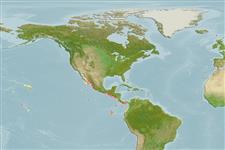Teleostei (teleosts) >
Beloniformes (Needle fishes) >
Exocoetidae (Flyingfishes)
Etymology: Prognichthys: Taken from Progne, name of Philomela´s sister, transformed into a swallow in the Greek mithology + Greek, ichthys = fish (Ref. 45335).
Eponymy: Not a true eponym, Progne (sometimes Procne – see above) was metamorphosed into a swallow. Pliny likened flyingfish to the swallow, and the genus name can be translated as ‘swallow-fish’. (Ref. 128868), visit book page.
Environment: milieu / climate zone / depth range / distribution range
Ecology
Marine; pelagic-neritic; oceanodromous; depth range 0 - ? m. Tropical; 28°N - 1°S
Eastern Central Pacific: Gulf of California to Ecuador.
Size / Weight / Age
Maturity: Lm ? range ? - ? cm
Max length : 16.0 cm SL male/unsexed; (Ref. 9300)
Epipelagic and neritic in coastal waters (Ref. 36606). May leap out of the water and glide for considerable distances from the surface. Oviparous, with planktonic larvae (Ref. 36606). Eggs are presumably attached to one another or floating objects via filaments (Ref. 36606).
Life cycle and mating behavior
Maturity | Reproduction | Spawning | Eggs | Fecundity | Larvae
Parin, N.V., 1995. Exocoetidae. Peces voladores. p. 1091-1103. In W. Fischer, F. Krupp, W. Schneider, C. Sommer, K.E. Carpenter and V. Niem (eds.) Guia FAO para Identification de Especies para lo Fines de la Pesca. Pacifico Centro-Oriental. 3 Vols. FAO, Rome. (Ref. 9300)
IUCN Red List Status (Ref. 130435: Version 2024-1)
Threat to humans
Harmless
Human uses
Tools
Special reports
Download XML
Internet sources
Estimates based on models
Preferred temperature (Ref.
123201): 15.9 - 26.1, mean 21.4 °C (based on 34 cells).
Phylogenetic diversity index (Ref.
82804): PD
50 = 0.5156 [Uniqueness, from 0.5 = low to 2.0 = high].
Bayesian length-weight: a=0.00631 (0.00288 - 0.01384), b=3.05 (2.85 - 3.25), in cm total length, based on LWR estimates for this (Sub)family-body shape (Ref.
93245).
Trophic level (Ref.
69278): 3.4 ±0.4 se; based on size and trophs of closest relatives
Resilience (Ref.
120179): High, minimum population doubling time less than 15 months (Preliminary K or Fecundity.).
Fishing Vulnerability (Ref.
59153): Low vulnerability (10 of 100).
